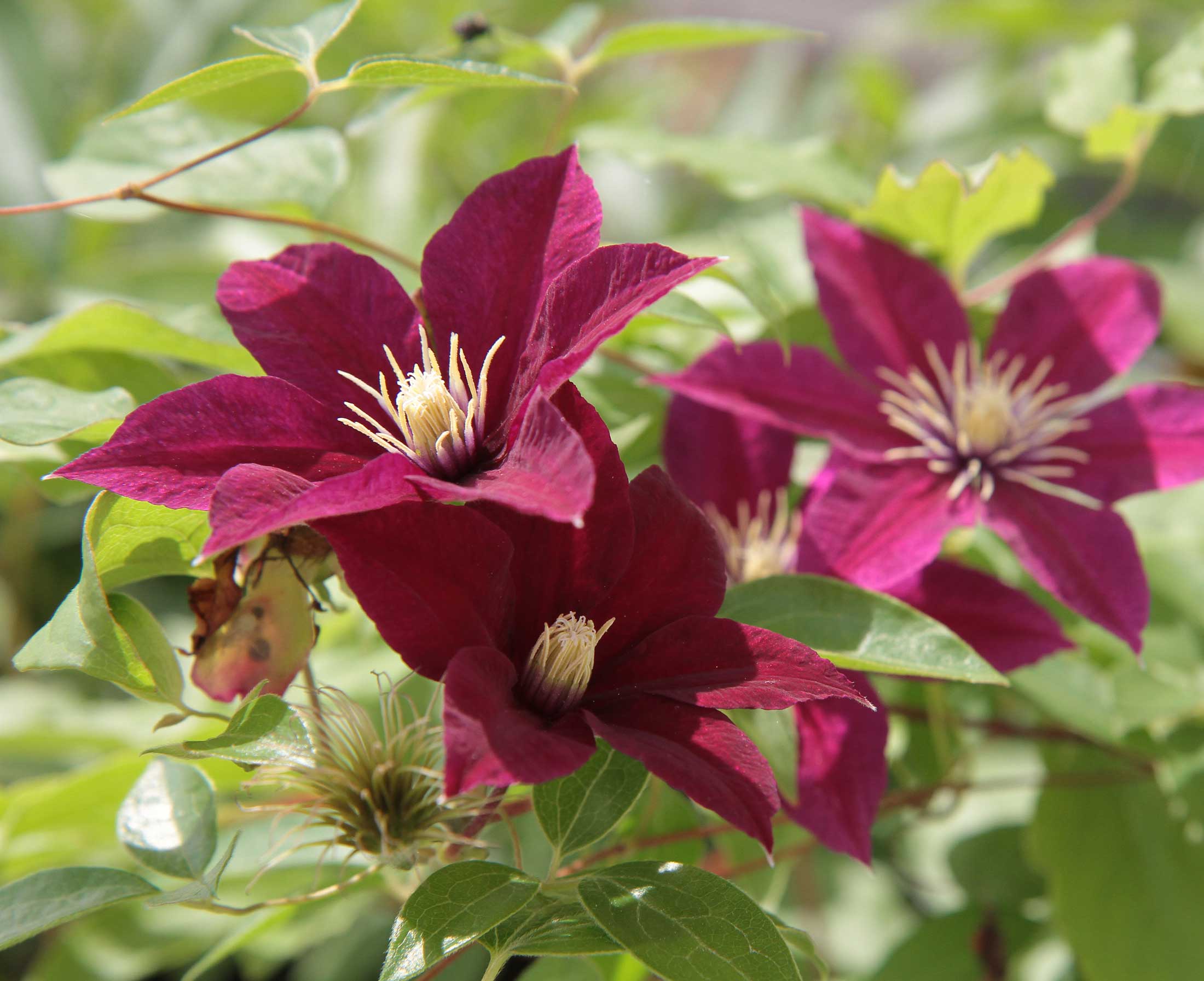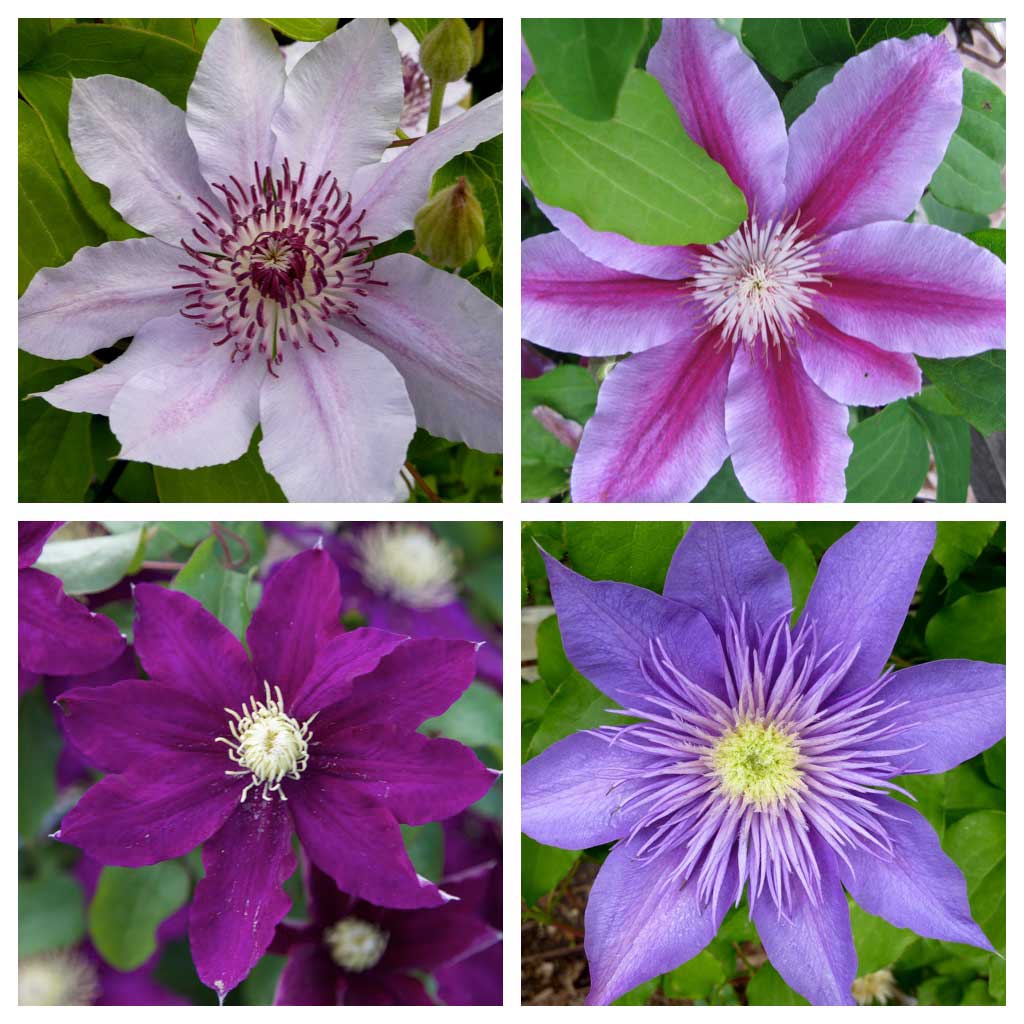Give Your Garden a Lift with Clematis

Clematis and other flowering vines play a special role in flower gardens. Since these plants grow up rather than out, they fill spaces that other plants can’t, and introduce a whole new dimension of color and texture.
In Britain, most flower gardens include one or more clematis vines. Here in the U.S, they are far less common. This is probably because people aren’t sure where to plant them. So here’s a quick primer about clematis: how they climb, what they like to climb on and the growing conditions they prefer.
How a Clematis Vine Climbs
Vines climb in a few different ways. Some have twining stems (like morning glory and pole beans), some have stem tendrils (grapes and peas). Others have aerial stem roots (climbing hydrangeas and English ivy) or specialized gripping pads (Boston ivy and Virginia creeper). There are also “scramblers”, which can’t really climb on their own, but can lie around and look pretty or be tied up onto a structure (climbing roses and bougainvillea).
Clematis have leaf tendrils. When the plant’s leaves are young, the leaf stems are supple and can themselves wrap around things. You can see them at work in the upper left corner of the photo above. Unlike stem tendrils, leaf tendrils are relatively short, which means they can only grab onto something with a diameter of less than about 1/4″. This is important to remember when it comes to providing the right kind of support.
How to Support a Clematis Vine
Though some types of clematis have a bushy growth habit, most cultivars are born to climb. And as with other climbing plants, these vines are always on a mission, searching for something to grab onto. If there’s nothing to grab, that section of the vine will stop growing and die back. This is why clematis need the right type of support to grow well and look good.
One of the simplest and most effective trellises for a clematis is a grid of coated or uncoated wire. The openings should be at least 2” in diameter. A smaller mesh size (like ½” hardware cloth) does not work because the leaf tendrils can’t push their way through the grid. A simple and effective option is 14-gauge welded wire with a black or green poly coating and a 2” x 3” grid. It’s a bit stiff to work with, but is strong and long-lasting.

Sweet Autumn Clematis
Welded steel concrete reinforcing wire (sometimes called remesh) usually has a 4″ x 4″ grid. This makes a great trellis for clematis and it will easily last 10 years or more. The only downside is you will need a pickup truck to transport the heavy rolls (or large flat grids), bolt cutters to cut the wire, and lots of hand strength to bend it into place. Reinforcing wire is also strong enough to be free-standing, and that can open up lots of creative trellising options.
In some situations, a lighter wire mesh – still with at least 2” openings – works best. Because it’s more flexible, you can wrap this sort of trellis around a lamp post or mailbox post, or drape it up and over a picket fence. This sort of mesh can also be used to modify a standard wooden trellis or wooden arbor so it’s more clematis friendly.

Where to Plant a Clematis
A happy clematis plant can live for 50 years or more, so take time to select a good planting spot. The plants have vigorous root systems and grow best in rich, loamy, well-drained soil. The roots prefer to be cool and consistently moist (though not wet). You’ll get more flowers if your plant is in full sun, though some varieties are fine with half-day sun (including Jackmanii, Nelly Moser and Henryi).
In Britain, clematis are often planted on free-standing, pyramidal trellises known as obelisks or tuteurs (see photo below). These are positioned within a perennial bed to add visual interest and show off the flowers. This type of support is also ideal for the plant, because neighboring perennials keep the soil cool by shading the root zone. The top of the vine gets good air circulation and lots of sun, and that encourages good flower production.

Clematis Polish Spirit on a wooden tuteur
Here are a few places to consider planting clematis:
- Against a wall of your house (though not under an overhang where it won’t get any rain)
- On a fence (attach wire mesh if needed)
- Near a shrub or small tree (so it can climb up through the branches)
- With another vine (such as a climbing rose)
- Over an arbor or pergola (attach wire mesh if needed)
- On a stone wall (again, wire mesh can be helpful)
- On a free-standing trellis in your garden
- Around a lamp post or mailbox
- In a container with a trellis
How to Choose a Clematis
When selecting a plant for your garden, you’ll want to think about a of couple things, including the color, mature height and flower style. If you have room for a vigorous vine that will grow 10 or 20 feet tall, there are dozens of cultivars to choose from. But breeders are also introducing more compact clematis varieties that are ideal for small gardens and containers.
The standard clematis flower is a large, star-like blossom with 6 to 9 petals and measuring 5-6” across. There are also cultivars with smaller blossoms, double blossoms or lovely bell-like flowers. Colors range from white to wine red, lavender to deep purple. There are even yellow ones.

Clematis Niobe
Another thing to think about is the bloom time. Some varieties flower in early summer, while others bloom in midsummer. Re-blooming clematis such as Multi-Blue and Blue Light, typically put on a big show of flowers in early summer and then have a smaller flush of flowers in late summer.
If you have space, take a tip from British gardeners and plant two or more different varieties of clematis side by side. This will give you an ever-changing tapestry of different flower styles, colors and bloom times.
Ready to start shopping? Click HERE to see our complete selection. Learn more about growing clematis here: All About Clematis and 6 Tips for Growing Clematis.




Hi I’m in love with your plants, but mi question is your only sell bulbs?.. or you sell
plants too? I’m small gardener and we sell orchids, exotic plants an indoor small plants, I like to buy your beautiful selection but ready to sell plants, no bulbs… if this possible, pleas let me know.
Hi Reyna,
We do offer a limited selection of perennials under the “SHOP” tab on our home page. Some are sold as plugs and some as bare root plants.
I read your blog its very nice.
this was a helpful read thank you.
i have a clematis called Ross’ Star, and i have planted it at the base of a tea tree which is large and mature with open branches and pink flowers year round. Im thinking that the wire mesh you mentioned will be helpful for it to cling to, so i’m
thinking of putting some around some of the branches. roots will be shaded and growing up into the sun is the idea. I live in N.Z
Hi Sharon – Sounds like this will work well. Hope so! Wondering if you are on the N or S Island. Have traveled around NZ twice and it’s where I live in my dreams every night. 🙂
I don’t use internet to order. Can I send a cashiers check after you give me price, shipping.
, etc
Thank you
Hi – yes, just contact Maryanne in our customer service department and she can help you figure that out. Call 855-534-2733 or send an email via our website: longfield-gardens.com. We won’t have clematis available again until next spring.
Do you sell any of the North American Native varieties?
https://ahsgardening.org/wp-content/pdfs/Clematis_TAG_JA14.pdf
Hi – the clematis varieties that we sell are on our website. The selection changes from year to year.
I love your web site. I learned so much by reading it. Now I’m going to order a bunch of your Clematis plants and make sure I will do well raising them. Thank you for your help!
Mine hasn’t bloomed in years
If the plant looks healthy and just isn’t producing flowers, it may not be getting enough sun. Most clematis require full sun to bloom well.